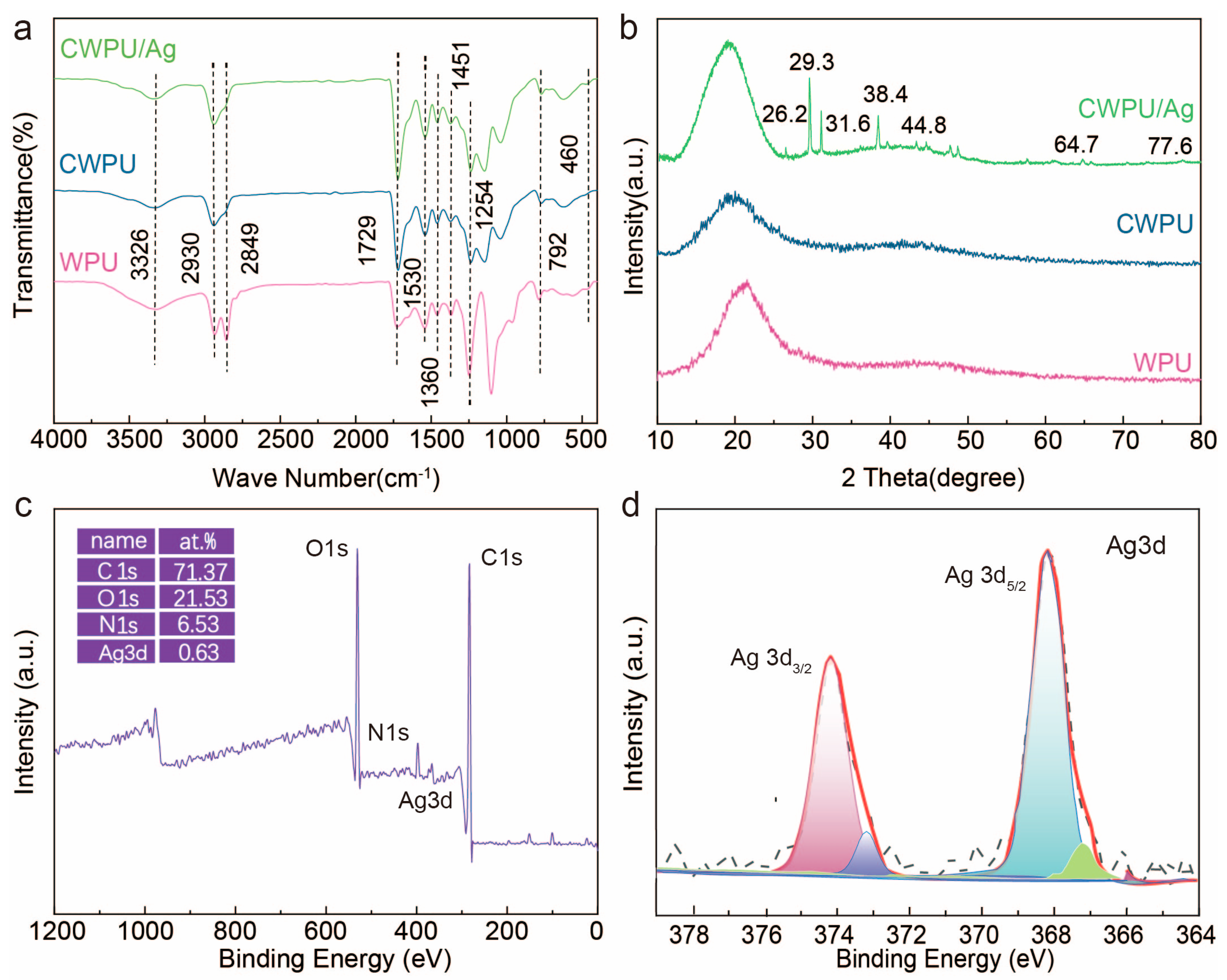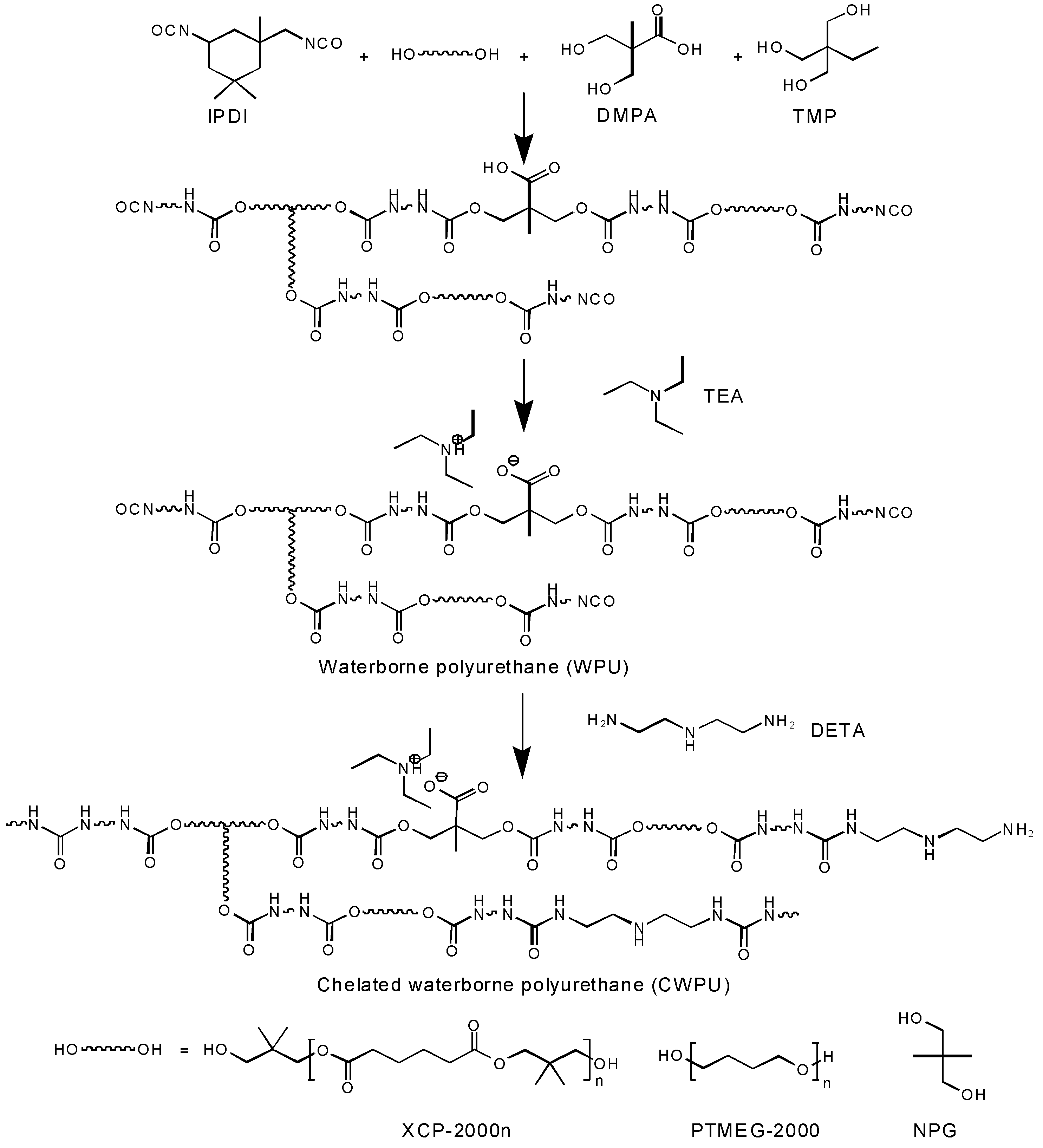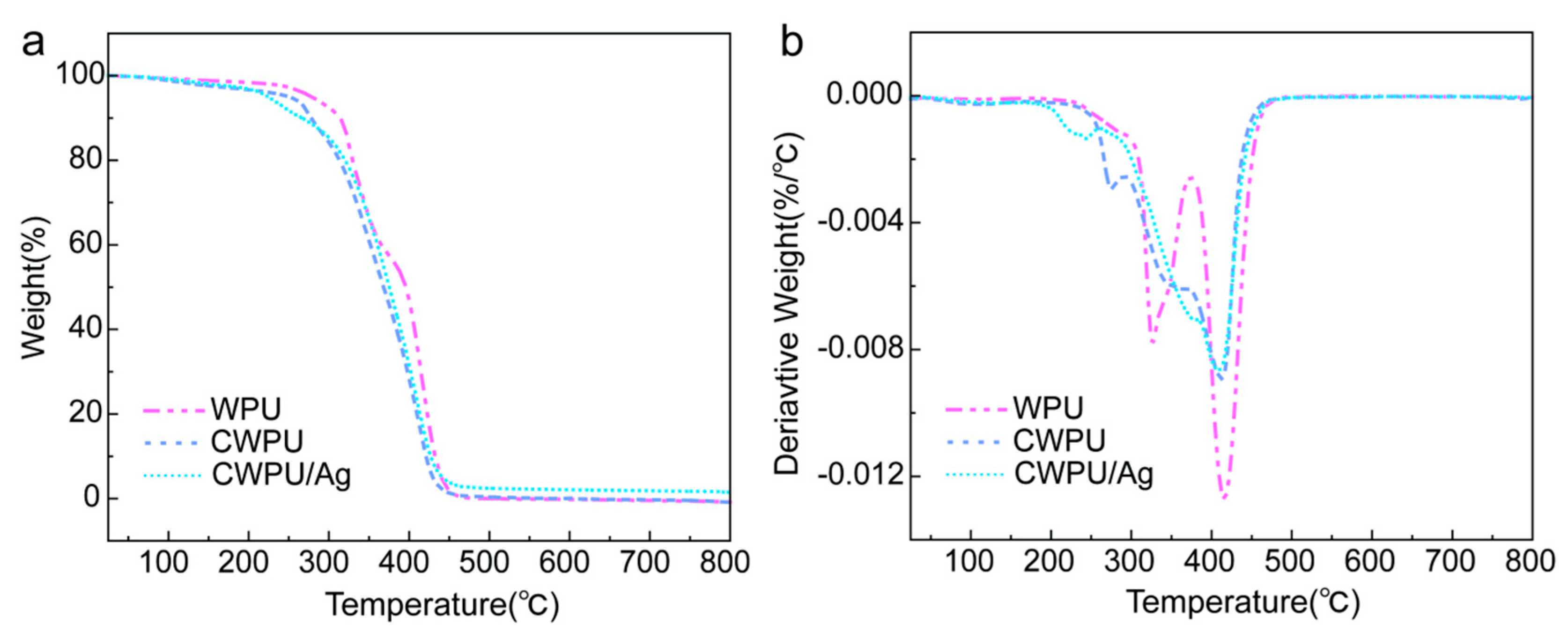Silver Ion-Chelated Waterborne Polyurethane Based Antibacterial Cotton Fabric via Coordination-Driven Immobilization
Abstract
1. Introduction
2. Experimental
2.1. Materials
2.2. Synthesis of WPU and CWPU
2.3. Preparation of WPU/Ag Dispersion
2.4. Preparation of Polyurethane Film
2.5. Preparation of Antibacterial Cotton Fabric
2.6. Characterization of WPU, CWPU and CWPU/Ag Thin Films
3. Results and Discussion
3.1. Synthesis of WPU/Ag and CWPU/Ag Dispersions
3.2. Surface Morphology of Films
3.3. Chemical Compositions of Films
3.3.1. FTIR Study
3.3.2. XRD Study
3.3.3. XPS Study

3.4. TGA Analysis of the Treated Film
3.5. Antibacterial Activity of the Treated Cotton Fabrics
3.6. Wettability of Films
3.7. Service Performance of the Treated Fabrics
4. Conclusions
Author Contributions
Funding
Institutional Review Board Statement
Informed Consent Statement
Data Availability Statement
Conflicts of Interest
References
- Zhao, A.; Sun, J.; Liu, Y. Understanding bacterial biofilms: From definition to treatment strategies. Front. Cell Infect. Microbiol. 2023, 6, 1137947. [Google Scholar] [CrossRef] [PubMed]
- Cui, D.; Liu, X.; Hawkey, P.; Li, H.; Wang, Q.; Mao, Z.; Sun, J. Use of and microbial resistance to antibiotics in China: A path to reducing antimicrobial resistance. Int. Med. Res. 2017, 45, 1768–1778. [Google Scholar] [CrossRef]
- Fernando, S.; Gunaskara, T.; Holton, J. Antimicrobial nanoparticles: Applications mechanisms of action Sri Lankan. J. Infect. Dis. 2018, 8, 2–11. [Google Scholar] [CrossRef]
- Casey, A.L.; Adams, D.; Karpanen, T.J.; Lambert, P.A.; Cookson, B.D.; Nightingale, P.; Elliott, T.S.J. Role of copper in reducing hospital environment contamination. J. Hosp. Infect. 2010, 74, 72–77. [Google Scholar] [CrossRef]
- Zhang, Y.; Li, Y.; Li, J.; Gao, Y.; Tan, H.; Wang, K.; Fu, Q. Synthesis and antibacterial characterization of waterborne polyurethanes with gemini quaternary ammonium salt. Sci. Bull. 2015, 60, 1114–1121. [Google Scholar] [CrossRef]
- Zeng, M.; Xu, J.; Luo, Q.; Hou, C.; Qiao, S.; Fu, S.; Liu, J. Constructing antibacterial polymer nanocapsules based on pyridine quaternary ammonium salt. Mater. Sci. Eng. C 2020, 108, 110383. [Google Scholar] [CrossRef]
- Ding, Q.; Liu, J.L.; Liu, Y.Y.; He, W.Z.; Zhang, L.; Xu, Y.J. Durable antibacterial cotton fabrics with good performance enabled by quaternary ammonium salts. Cellulose 2024, 31, 6551–6564. [Google Scholar] [CrossRef]
- Kathuria, D.; Raul, A.D.; Wanjari, P.; Bharatam, P.V. Biguanides: Species with versatile therapeutic applications. Eur. J. Med. Chem. 2021, 219, 113378. [Google Scholar] [CrossRef] [PubMed]
- Lin, Y.; He, S.; Wu, M.; Hou, M.; Li, R.; Zhang, A. Amphiphilic polysiloxane graft guanidine salts with a combination of low environmental toxicity and high antifungal activity. Eur. Polym. J. 2024, 216, 113258. [Google Scholar] [CrossRef]
- Yajie, W.; Qiang, G.; Jiqiang, C.; Xin, X.; Ying, W.; Han, S.; Lei, T.; Xiang, L. Superhydrophobic Antibacterial Aramid Fabric with Self-Cleaning, Ultraviolet Protection and Oil-water separation Functionalities. Text. Res. J. 2025. [Google Scholar] [CrossRef]
- Cui, J.; Shao, Y.; Zhang, H.; Zhang, H.; Zhu, J. Development of a novel silver ions-nanosilver complementary composite as antimicrobial additive for powder coating. Chem. Eng. J. 2021, 420, 127633. [Google Scholar] [CrossRef] [PubMed]
- Sun, Z.; Fan, C.; Tang, X.; Zhao, J.; Song, Y.; Shao, Z.; Xu, L. Characterization and antibacterial properties of porous fibers containing silver ions. Appl. Surf. Sci. 2016, 387, 828–838. [Google Scholar] [CrossRef]
- Panáček, A.; Kvítek, L.; Prucek, R.; Kolář, M.; Večeřová, R.; Pizúrová, N.; Zbořil, R. Silver colloid nanoparticles: Synthesis, characterization, and their antibacterial activity. J. Phys. Chem. B 2006, 110, 16248–16253. [Google Scholar] [CrossRef] [PubMed]
- Franci, G.; Falanga, A.; Galdiero, S.; Palomba, L.; Rai, M.; Morelli, G.; Galdiero, M. Silver nanoparticles as potential antibacterial agents. Molecules 2015, 20, 8856–8874. [Google Scholar] [CrossRef]
- Liu, X.; Chen, J.; Gu, L.; Nguyen, L.T.; Cao, J.; Liu, H.; Zhaoqun, D.; Weidong, Y. A superhydrophobic and flame-retardant cotton fabric fabricated by an eco-friendly assembling method. Text. Res. J. 2022, 92, 2873–2885. [Google Scholar] [CrossRef]
- Tabatabaee, F.; Khorasani, M.; Ebrahimi, M.; González, A.; Irusta, L.; Sardon, H. Synthesis and comprehensive study on industrially relevant flame retardant waterborne polyurethanes based on phosphorus chemistry. Prog. Org. Coat. 2019, 131, 397–406. [Google Scholar] [CrossRef]
- Lin, L.; Tu, Y.; Li, Z.; Wu, H.; Mao, H.; Wang, C. Synthesis and application of multifunctional lignin-modified cationic waterborne polyurethane in textiles. Int. J. Biol. Macromol. 2024, 262, 130063. [Google Scholar] [CrossRef] [PubMed]
- Wu, Q.; Hu, J. Waterborne polyurethane based thermoelectric composites and their application potential in wearable thermoelectric textiles. Compos. Part. B Eng. 2016, 107, 59–66. [Google Scholar] [CrossRef]
- Tuo, Y.; Luo, X.; Xiong, Y.; Xu, C.A.; Yuan, T. A Novel Polyfunctional Polyurethane Acrylate Derived from Castor Oil-Based Polyols for Waterborne UV-Curable Coating Application. Polymers 2024, 16, 949. [Google Scholar] [CrossRef]
- Luo, H.; Wei, H.; Wang, L.; Gao, Q.; Chen, Y.; Xiang, J.; Fan, H. Anti-smudge and self-cleaning characteristics of waterborne polyurethane coating and its construction. J. Colloid Interface Sci. 2022, 628, 1070–1081. [Google Scholar] [CrossRef]
- Tsou, C.H.; Lee, H.T.; Hung, W.S.; Wang, C.C.; Shu, C.C.; Suen, M.C.; De Guzman, M. Synthesis and properties of antibacterial polyurethane with novel Bis (3-pyridinemethanol) silver chain extender. Polymer 2016, 85, 96–105. [Google Scholar] [CrossRef]
- Fu, H.; Wang, Y.; Li, X.; Chen, W. Synthesis of vegetable oil-based waterborne polyurethane/silver-halloysite antibacterial nanocomposites. Compos. Sci. Technol. 2016, 126, 86–93. [Google Scholar] [CrossRef]
- Ali, A.; Amin, B.U.; Yu, W.; Gui, T.; Cong, W.; Zhang, K.; Zhang, Q. Eco-friendly biodegradable polyurethane based coating for antibacterial and antifouling performance. Chin. J. Chem. Eng. 2023, 54, 80–88. [Google Scholar] [CrossRef]
- Guo, Z.; Du, Y.; Lei, J.; Zhou, L.; Du, X. Oxidative Desulfurization of Fuel Oil at Room Temperature Catalyzed by Ordered Meso-macroporous HPW/SiO2. J. Wuhan Univ. Technol. -Mater. Sci. Ed. 2019, 34, 1071–1076. [Google Scholar] [CrossRef]
- Gies, A.P.; Hercules, D.M.; Raghuraman, A.; Kosanovich, A.J.; Baker, M.A.; Mukhopadhyay, S.; Paradkar, M. Microstructure characterization and mechanistic insight into polyether polyols and their associated polyurethanes. Mass. Spectrom. Rev. 2023. [Google Scholar] [CrossRef]
- Petrović, Z.S.; Javni, I.; Divjaković, V. Structure and physical properties of segmented polyurethane elastomers containing chemical crosslinks in the hard segment. J. Polym. Sci. Pol. Phys. 1998, 36, 221–235. [Google Scholar] [CrossRef]
- Rosu, D.; Rosu, L.; Varganici, C. The thermal stability of some semi-interpenetrated polymer networks based on epoxy resin and aromatic polyurethane. J. Anal. Appl. Pyrolysis 2013, 100, 103–110. [Google Scholar] [CrossRef]
- Macocinschi, D.; Filip, D.; Zaltariov, M.F.; Varganici, C.D. Thermal and hydrolytic stability of silver nanoparticle polyurethane biocomposites for medical applications. Polym. Degrad. Stab. 2015, 121, 238–246. [Google Scholar] [CrossRef]
- Mohammadi, A.; Doctorsafaei, A.H.; Burujeny, S.B.; Rudbari, H.A.; Kordestani, N.; Najafabadi, S.A.A. Silver(I) complex with a Schiff base ligand extended waterborne polyurethane: A developed strategy to obtain a highly stable antibacterial dispersion impregnated with in situ formed silver nanoparticles. Chem. Eng. J. 2020, 381, 122776. [Google Scholar] [CrossRef]
- Saitaer, X.; Wang, J.; Gao, Q.; Li, Y.; Sun, J.; Cao, J.; Wang, Y.; Liu, Z.; Liu, X. Preparation of Superhydrophobic Flame-Retardant UHMWPE Fabrics with Excellent Mechanical Stability by Simple Coating Method. Coatings 2025, 15, 366. [Google Scholar] [CrossRef]






| Sample | Type of Chain Extender | Molarratio (IPDI:polyol:TMP:NPG:DMPA:DETA:Ag+) | Silver Ion Content (in Dry Film) | Silver Ion Concentration (ppm) |
|---|---|---|---|---|
| WPU | NGP | 12:1:0.2:7.3:3:0:0 | 0 | 0 |
| CWPU | NGP + DETA | 12:1:0.2:6.3:3:1:0 | 0 | 0 |
| WPU/Ag | NGP | 12:1:0.2:7.3:3:0:0.35 | 0.64 | 2500 |
| CWPU/Ag | NGP + DETA | 12:1:0.2:6.3:3:1:0.35 | 0.64 | 2500 |
| Sample | T5% (°C) | T10% (°C) | T50% (°C) | Tmax,1 (°C) | Tmax,2 (°C) |
|---|---|---|---|---|---|
| WPU | 279 | 313 | 396 | 327 | 418 |
| CWPU | 250 | 278 | 368 | 276 | 412 |
| CWPU/Ag | 224 | 267 | 375 | 245 | 408 |
Disclaimer/Publisher’s Note: The statements, opinions and data contained in all publications are solely those of the individual author(s) and contributor(s) and not of MDPI and/or the editor(s). MDPI and/or the editor(s) disclaim responsibility for any injury to people or property resulting from any ideas, methods, instructions or products referred to in the content. |
© 2025 by the authors. Licensee MDPI, Basel, Switzerland. This article is an open access article distributed under the terms and conditions of the Creative Commons Attribution (CC BY) license (https://creativecommons.org/licenses/by/4.0/).
Share and Cite
Gao, Q.; Wang, Y.; Wang, J.; Sun, J.; Cao, J.; Liu, Z.; Liu, X. Silver Ion-Chelated Waterborne Polyurethane Based Antibacterial Cotton Fabric via Coordination-Driven Immobilization. Coatings 2025, 15, 631. https://doi.org/10.3390/coatings15060631
Gao Q, Wang Y, Wang J, Sun J, Cao J, Liu Z, Liu X. Silver Ion-Chelated Waterborne Polyurethane Based Antibacterial Cotton Fabric via Coordination-Driven Immobilization. Coatings. 2025; 15(6):631. https://doi.org/10.3390/coatings15060631
Chicago/Turabian StyleGao, Qiang, Yajie Wang, Jianing Wang, Jiahao Sun, Jiqiang Cao, Zengying Liu, and Xiang Liu. 2025. "Silver Ion-Chelated Waterborne Polyurethane Based Antibacterial Cotton Fabric via Coordination-Driven Immobilization" Coatings 15, no. 6: 631. https://doi.org/10.3390/coatings15060631
APA StyleGao, Q., Wang, Y., Wang, J., Sun, J., Cao, J., Liu, Z., & Liu, X. (2025). Silver Ion-Chelated Waterborne Polyurethane Based Antibacterial Cotton Fabric via Coordination-Driven Immobilization. Coatings, 15(6), 631. https://doi.org/10.3390/coatings15060631






